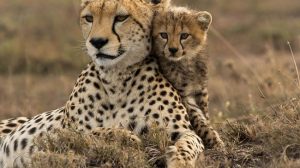In the tough terrains of Africa, a fast and strong hunter quietly moves – the cheetah. Picture an animal so speedy that it can go from 0 to 60 miles per hour (0-97 kph) in just a few seconds, faster than even the quickest sports cars. The cheetah, with its special spotted coat and tear marks on its face, is a living example of speed, power, and outstanding beauty.

Come along with us as we explore the secrets of this amazing cat, learning about its special traits, its population challenges, where it lives around the world, and the efforts being made to keep it safe.
Cheetahs (Acinonyx jubatus) stand out not only for their incredible speed but also for their distinctive physical attributes. Their slender, aerodynamic bodies are adorned with beautiful black spots scattered across a golden coat. One cannot help but marvel at the black tear marks on their faces, like nature’s mascara highlighting their keen, amber eyes. These marks serve a functional purpose, reducing the sun’s glare and enhancing their focus while hunting.
Unlike other big cats, cheetahs lack the brute strength to overpower their prey but rely on unmatched acceleration and agility to outmanoeuvre them. This is why they are recognised as the world’s fastest land mammal, astounding with their ability to accelerate, reaching speeds of zero to 60 miles an hour in three seconds. Although wild cheetahs are believed to hit nearly 70 miles an hour, their sprint is short-lived, lasting around 30 seconds. Displaying exceptional agility at high speeds, cheetahs adeptly navigate quick and sudden turns while chasing prey.
To add up, a persistent discussion regarding whether cheetahs qualify as “big cats” centres on their incapacity to produce roars. This characteristic sets lions, tigers, jaguars, and leopard apart. They communicate through a unique vocabulary of purrs, growls, and chirps. Although cheetahs lack this vocalisation feature, their inclusion within the broader classification of “big cats” is supported by conservation groups.
Population and Conservation
Despite their captivating prowess, cheetahs face a sobering reality – their populations are dwindling. The International Union for Conservation of Nature (IUCN) classifies cheetahs as vulnerable, with an estimated 7,000 individuals remaining in the wild. The expansion of human settlements, poaching, and habitat loss severely threaten these magnificent creatures. Cheetahs need large territories to thrive as the fastest land animals, making their conservation a complex puzzle that demands urgent attention.
Conservationists and organisations worldwide are working tirelessly to ensure the survival of cheetahs. For instance, the Cheetah Conservation Fund (CCF) in Namibia is dedicated to researching and implementing strategies to protect cheetahs and their habitats. Efforts include promoting coexistence between farmers and cheetahs, mitigating human-wildlife conflict, and establishing protected areas.
Governments, NGOs, and local communities play pivotal roles in preserving these iconic cats. Education and awareness campaigns are crucial, as fostering a sense of responsibility and understanding is key to securing a future for cheetahs. Collaborative initiatives, such as the Global Cheetah Action Plan, unite nations in a shared commitment to conservation, recognising that saving the cheetah requires a global effort.
As we learn more about cheetahs, it’s clear they need our help urgently. Whether future generations get to see a cheetah in full sprint or only read about them depends on what we do now. Cheetahs remind us how we need to balance our actions with nature. Every action we take affects the animals we share the Earth with. The fate of the cheetah is connected to our ability to live together peacefully with nature, protecting the incredible diversity that makes our planet special.
Let’s promise to take care of the wild and be champions for those who can’t speak for themselves. The race is on, not just for the cheetah but for the future of our planet. Will we be quick enough to ensure a future where these amazing cats keep racing across the savannas, or will we let the sound of their footsteps fade away into silence? It’s up to us, and the time to decide is now.
By Assaf Levy, BioDB
